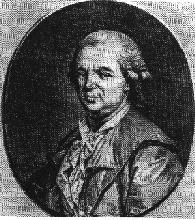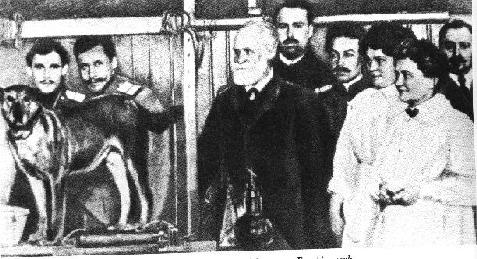Landmarks in Psychology
 Philppe Pinel unchains the "insane" in the Bicetre asylum in Paris, 1793.(painting by Ch. Muller)
Philppe Pinel unchains the "insane" in the Bicetre asylum in Paris, 1793.(painting by Ch. Muller)
At Bicetre asylum, Pinel (1745-1816) not only removed the chains of the mentally ill, but he instituted a regimen which was free from the insensate bloodletting, purging, and dunking that were
the common treatment of the day. In Pinel's treatise on mental alienation, Nosographie Philosophique,
he classifies mental diseases according to symptoms, discusses many individual cases, and outlines the course of treatment, which was along the lines of diet, encouragement, and the least restrictive setting - in general, modern
psychotherapy. The term "medico-philosophical" in the title of Pinel's book indicates his disagreement with the
purely physical remedies in vogue at that time.
 Mesmer (1733-1815) asserted the existence of a power, similar to magnetism, that excercises an extraordinary influence on the human body. This power he called "animal magnetism", and in 1775 he published an account of his discovery, claiming it had medicinal value. Mesmer successfully used his new system to cure patients. His technique received some support among members of the medical profession. In 1785 the French government was induced to appoint an investigative commision composed of physicians and scientists (one of its members was Benjamin Franklin). The committee's report was unfavorable to Mesmer's theory. Mesmer subsequently fell into disrepute and spent the rest of his life in obscurity. Since Mesmer's day, the subject has been elevated to that of scientific research. The mesmeric trance is today identified as hypnosis, and its value in the management of certain conditions has received widespread support.
Mesmer (1733-1815) asserted the existence of a power, similar to magnetism, that excercises an extraordinary influence on the human body. This power he called "animal magnetism", and in 1775 he published an account of his discovery, claiming it had medicinal value. Mesmer successfully used his new system to cure patients. His technique received some support among members of the medical profession. In 1785 the French government was induced to appoint an investigative commision composed of physicians and scientists (one of its members was Benjamin Franklin). The committee's report was unfavorable to Mesmer's theory. Mesmer subsequently fell into disrepute and spent the rest of his life in obscurity. Since Mesmer's day, the subject has been elevated to that of scientific research. The mesmeric trance is today identified as hypnosis, and its value in the management of certain conditions has received widespread support.
 Pavlov and his staff in their laboratory, 1897.
Pavlov and his staff in their laboratory, 1897.
The greatest name in Russian physiology, which has influenced all the mental sciences, is that of Pavlov (1849-1936). His famous experiments on coditioned reflexs in dogs, revealing much new information on the process of digestion, earned him the Nobel Prize in 1904. The experiments were intended to demonstrate that no conscious process of mental association was needed to produce such responses, but that it took place on an unconscious level, like digestion itself. Pavlov's "reflexology" became the psychophysiological gospel in all USSR institutions of learning and was used, as most believe, in the"molding of the masses".Pavlov himself was far from committing himself to this purely rigid philosophy. He was opposed to Communism and because he lived in a time before Stalin had engaged in his ruthless purges, Pavlov enjoyed freedom and status. His major work is Conditioned Reflexes (1926; trans 1927). Pavlov had a substantial impact on the physiological behaviorist and behaviorism in general during the early 20th century
Landmarks of Psychology, part two 
 back to Alaska Psychosocial Services
back to Alaska Psychosocial Services
early "treatment" /
perception /
art of mental disorder /
medical and mental health links